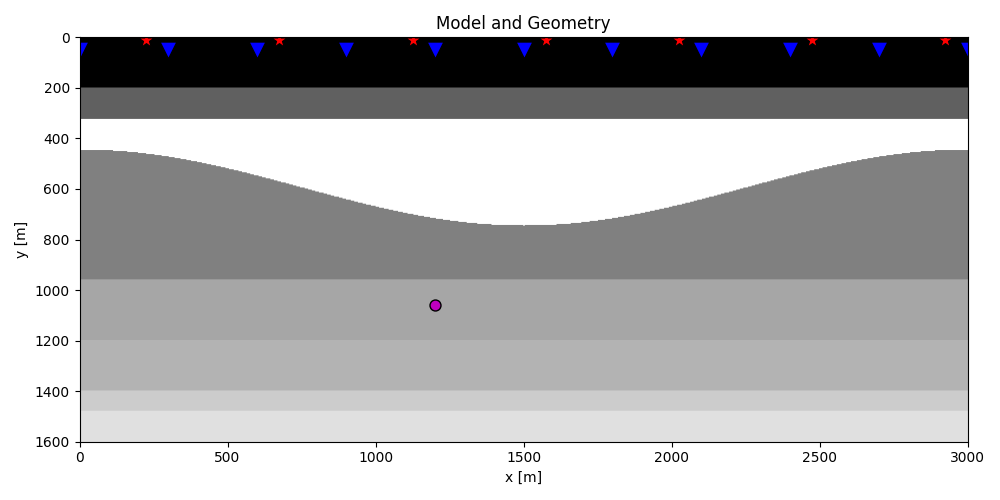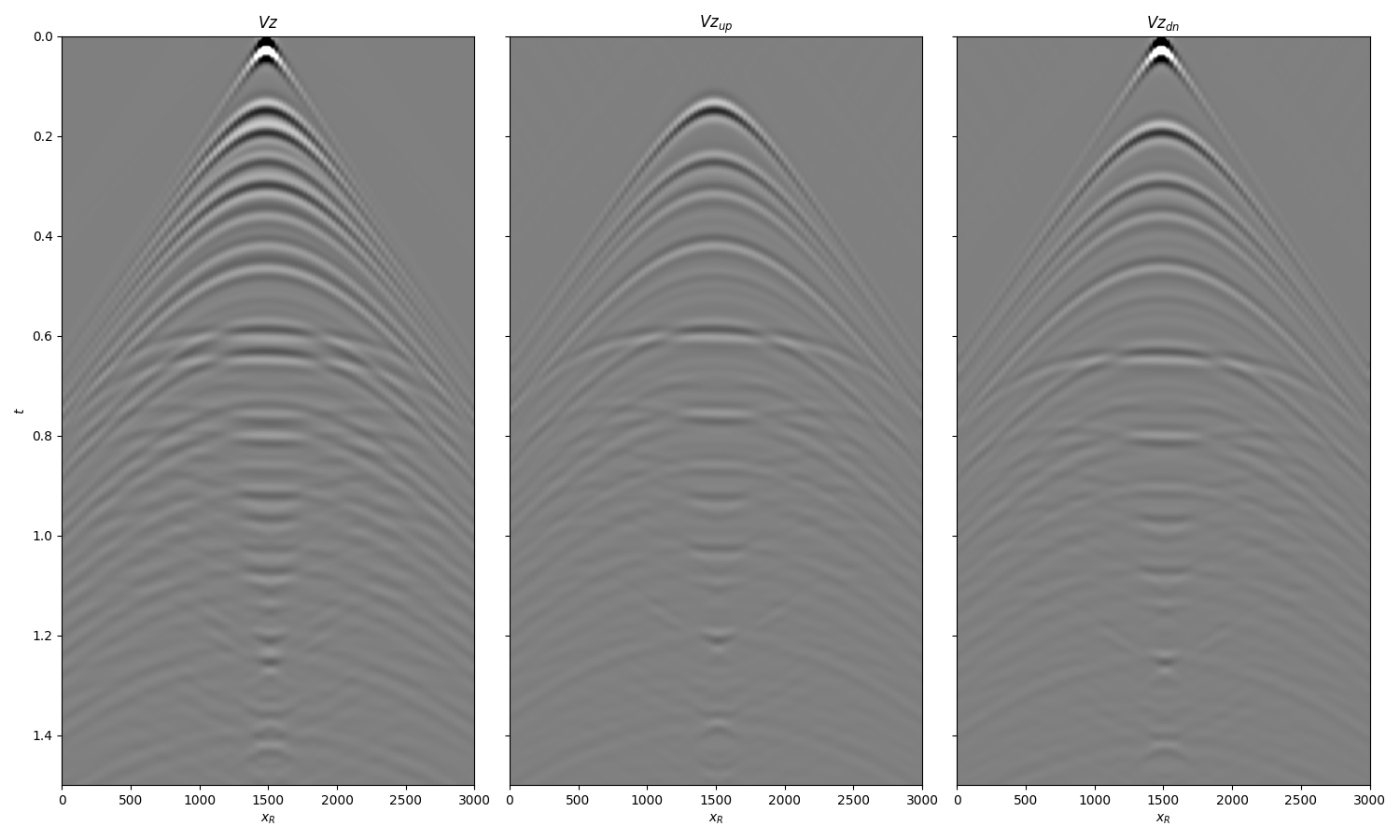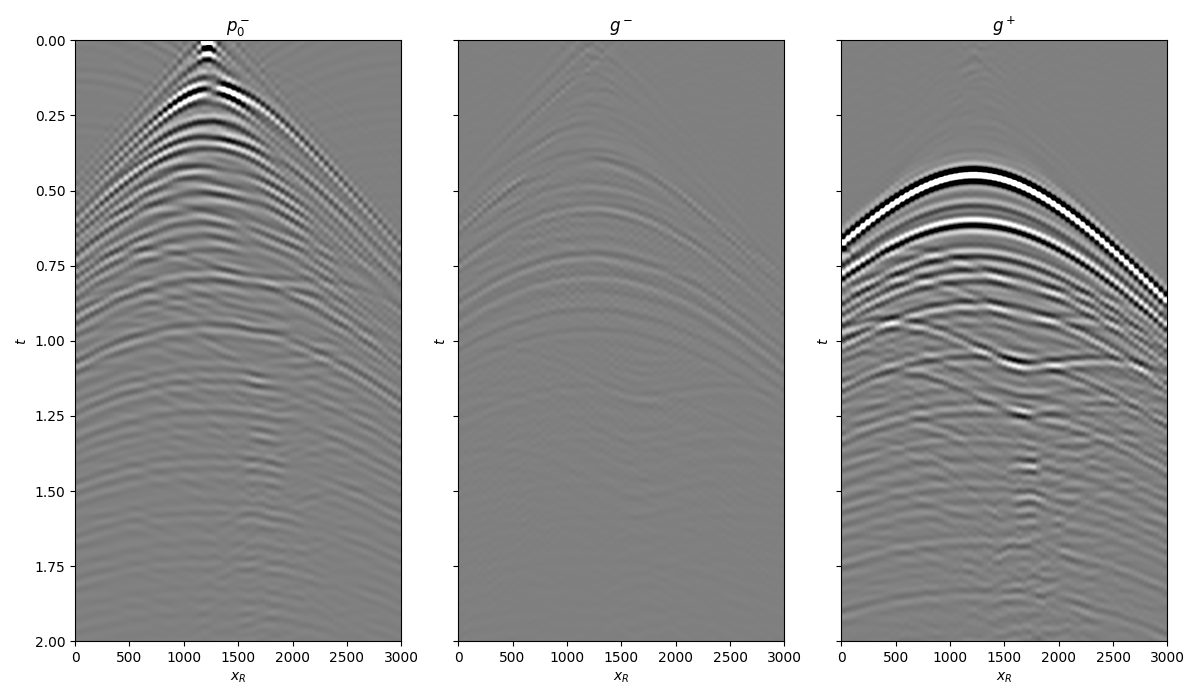Note
Go to the end to download the full example code
4. Rayleigh-Marchenko redatuming#
This example shows how to set-up and run the
pymarchenko.raymarchenko.RayleighMarchenko algorithm using
synthetic data.
# sphinx_gallery_thumbnail_number = 5
# pylint: disable=C0103
import warnings
import numpy as np
import matplotlib.pyplot as plt
from scipy.signal import convolve
from pymarchenko.raymarchenko import RayleighMarchenko
warnings.filterwarnings('ignore')
plt.close('all')
Let’s start by defining some input parameters and loading the geometry
# Input parameters
inputfile = '../testdata/raymarchenko/input.npz'
vel = 2400.0 # velocity
tsoff = 0.06 # direct arrival time shift source side
troff = 0.06 # direct arrival time shift receiver side
nsmooth = 10 # time window smoothing
nfmax = 550 # max frequency for MDC (#samples)
niter = 30 # iterations
convolvedata = True # Apply convolution to data
inputdata = np.load(inputfile)
# Receivers
r = inputdata['r']
nr = r.shape[1]
dr = r[0, 1]-r[0, 0]
# Sources
s = inputdata['s']
ns = s.shape[1]
ds = s[0, 1]-s[0, 0]
# Virtual points
vs = inputdata['vs']
# Density model
rho = inputdata['rho']
z, x = inputdata['z'], inputdata['x']
plt.figure(figsize=(10, 5))
plt.imshow(rho, cmap='gray', extent=(x[0], x[-1], z[-1], z[0]))
plt.scatter(s[0, 5::10], s[1, 5::10], marker='*', s=150, c='r', edgecolors='k')
plt.scatter(r[0, ::10], r[1, ::10], marker='v', s=150, c='b', edgecolors='k')
plt.scatter(vs[0], vs[1], marker='.', s=250, c='m', edgecolors='k')
plt.axis('tight')
plt.xlabel('x [m]')
plt.ylabel('y [m]')
plt.title('Model and Geometry')
plt.xlim(x[0], x[-1])
plt.tight_layout()

Let’s now load and display the up and downgoing particle velocity data and subsurface fields
# Time axis
t = inputdata['t']
ot, dt, nt = t[0], t[1]-t[0], len(t)
# Wavelet
wav = inputdata['wav']
wav_c = np.argmax(wav)
# Reflection data (R[s, r, t]) and subsurface fields
Vzu = inputdata['Vzu']
Vzd = inputdata['Vzd']
# Convolve data with wavelet
if convolvedata:
Vzu = dt * np.apply_along_axis(convolve, -1, Vzu, wav, mode='full')
Vzu = Vzu[..., wav_c:][..., :nt]
Vzd = dt * np.apply_along_axis(convolve, -1, Vzd, wav, mode='full')
Vzd = Vzd[..., wav_c:][..., :nt]
fig, axs = plt.subplots(1, 3, sharey=True, figsize=(15, 9))
axs[0].imshow(Vzu[ns//2].T+Vzd[ns//2].T, cmap='gray', vmin=-1e-1, vmax=1e-1,
extent=(r[0,0], r[0,-1], t[-1], t[0]))
axs[0].set_title(r'$Vz$')
axs[0].set_xlabel(r'$x_R$')
axs[0].set_ylabel(r'$t$')
axs[0].axis('tight')
axs[0].set_ylim(1.5, 0)
axs[1].imshow(Vzu[ns//2].T, cmap='gray', vmin=-1e-1, vmax=1e-1,
extent=(r[0,0], r[0,-1], t[-1], t[0]))
axs[1].set_title(r'$Vz_{up}$')
axs[1].set_xlabel(r'$x_R$')
axs[1].axis('tight')
axs[1].set_ylim(1.5, 0)
axs[2].imshow(Vzd[ns//2].T, cmap='gray', vmin=-1e-1, vmax=1e-1,
extent=(r[0,0], r[0,-1], t[-1], t[0]))
axs[2].set_title(r'$Vz_{dn}$')
axs[2].set_xlabel(r'$x_R$')
axs[2].axis('tight')
axs[2].set_ylim(1.5, 0)
fig.tight_layout()

And subsurface fields
Gsub = inputdata['Gsub']
G0sub = inputdata['G0sub']
Gsub = np.apply_along_axis(convolve, 0, Gsub, wav, mode='full')
Gsub = Gsub[wav_c:][:nt]
G0sub = np.apply_along_axis(convolve, 0, G0sub, wav, mode='full')
G0sub = G0sub[wav_c:][:nt]
# Convolve reference Green's function with wavelet
if convolvedata:
Gsub = dt * np.apply_along_axis(convolve, 0, Gsub, wav, mode='full')
Gsub = Gsub[wav_c:][:nt]
fig, axs = plt.subplots(1, 2, sharey=True, figsize=(8, 6))
axs[0].imshow(Gsub, cmap='gray', vmin=-1e7, vmax=1e7,
extent=(s[0, 0], s[0, -1], t[-1], t[0]))
axs[0].set_title('G')
axs[0].set_xlabel(r'$x_R$')
axs[0].set_ylabel(r'$t$')
axs[0].axis('tight')
axs[0].set_ylim(1.5, 0)
axs[1].imshow(G0sub, cmap='gray', vmin=-1e7, vmax=1e7,
extent=(r[0, 0], r[0, -1], t[-1], t[0]))
axs[1].set_title('G0')
axs[1].set_xlabel(r'$x_R$')
axs[1].set_ylabel(r'$t$')
axs[1].axis('tight')
axs[1].set_ylim(1.5, 0)
fig.tight_layout()

Let’s now create an object of the
pymarchenko.raymarchenko.RayleighMarchenko class and apply
redatuming for a single subsurface point vs.
# Direct arrival traveltimes
travs = np.sqrt((vs[0]-s[0])**2+(vs[1]-s[1])**2)/vel
travr = np.sqrt((vs[0]-r[0])**2+(vs[1]-r[1])**2)/vel
rm = RayleighMarchenko(Vzd, Vzu, dt=dt, dr=dr,
nfmax=nfmax, wav=wav, toff=troff, nsmooth=nsmooth,
dtype='float64', saveVt=True, prescaled=False)
f1_inv_minus, f1_inv_plus, p0_minus, g_inv_minus, g_inv_plus = \
rm.apply_onepoint(travs, travr, G0=G0sub.T, rtm=True, greens=True,
dottest=True, **dict(iter_lim=niter, show=True))
g_inv_tot = -(g_inv_minus + g_inv_plus)
Dot test passed, v^H(Opu)=-62.2757380961439 - u^H(Op^Hv)=-62.2757380961445
Dot test passed, v^H(Opu)=-26.251245996755546 - u^H(Op^Hv)=-26.25124599675556
LSQR Least-squares solution of Ax = b
The matrix A has 267866 rows and 403798 columns
damp = 0.00000000000000e+00 calc_var = 0
atol = 1.00e-06 conlim = 1.00e+08
btol = 1.00e-06 iter_lim = 30
Itn x[0] r1norm r2norm Compatible LS Norm A Cond A
0 0.00000e+00 7.383e+08 7.383e+08 1.0e+00 9.4e-10
1 9.04919e+04 5.220e+08 5.220e+08 7.1e-01 6.3e-01 9.9e-01 1.0e+00
2 2.20830e+04 3.413e+08 3.413e+08 4.6e-01 4.4e-01 1.4e+00 2.5e+00
3 8.57234e+04 2.912e+08 2.912e+08 3.9e-01 3.7e-01 1.9e+00 4.0e+00
4 1.91895e+05 2.297e+08 2.297e+08 3.1e-01 2.4e-01 2.6e+00 6.3e+00
5 1.99985e+05 1.924e+08 1.924e+08 2.6e-01 1.9e-01 2.9e+00 8.1e+00
6 2.28755e+05 1.683e+08 1.683e+08 2.3e-01 1.3e-01 3.2e+00 9.9e+00
7 4.20123e+05 1.461e+08 1.461e+08 2.0e-01 1.5e-01 3.4e+00 1.2e+01
8 4.20946e+05 1.258e+08 1.258e+08 1.7e-01 1.3e-01 3.7e+00 1.4e+01
9 4.32414e+05 1.122e+08 1.122e+08 1.5e-01 1.1e-01 3.9e+00 1.7e+01
10 5.42342e+05 1.019e+08 1.019e+08 1.4e-01 1.0e-01 4.1e+00 1.9e+01
20 5.75490e+05 4.917e+07 4.917e+07 6.7e-02 5.5e-02 5.8e+00 4.9e+01
21 5.41632e+05 4.596e+07 4.596e+07 6.2e-02 5.3e-02 6.0e+00 5.3e+01
22 5.01525e+05 4.297e+07 4.297e+07 5.8e-02 4.9e-02 6.1e+00 5.6e+01
23 4.61134e+05 4.019e+07 4.019e+07 5.4e-02 4.8e-02 6.2e+00 6.0e+01
24 4.38557e+05 3.813e+07 3.813e+07 5.2e-02 4.4e-02 6.3e+00 6.3e+01
25 4.04307e+05 3.613e+07 3.613e+07 4.9e-02 4.3e-02 6.4e+00 6.7e+01
26 3.47775e+05 3.398e+07 3.398e+07 4.6e-02 4.5e-02 6.5e+00 7.1e+01
27 3.29531e+05 3.203e+07 3.203e+07 4.3e-02 4.0e-02 6.6e+00 7.5e+01
28 3.30142e+05 3.029e+07 3.029e+07 4.1e-02 4.0e-02 6.7e+00 7.8e+01
29 3.26705e+05 2.887e+07 2.887e+07 3.9e-02 4.0e-02 6.8e+00 8.2e+01
30 3.27919e+05 2.741e+07 2.741e+07 3.7e-02 3.6e-02 6.9e+00 8.6e+01
LSQR finished
The iteration limit has been reached
istop = 7 r1norm = 2.7e+07 anorm = 6.9e+00 arnorm = 6.8e+06
itn = 30 r2norm = 2.7e+07 acond = 8.6e+01 xnorm = 1.8e+09
We can now compare the result of Rayleigh-Marchenko redatuming with standard redatuming
fig, axs = plt.subplots(1, 3, sharey=True, figsize=(12, 7))
axs[0].imshow(p0_minus.T, cmap='gray', vmin=-1e7, vmax=1e7,
extent=(r[0, 0], r[0, -1], t[-1], -t[-1]))
axs[0].set_title(r'$p_0^-$')
axs[0].set_xlabel(r'$x_R$')
axs[0].set_ylabel(r'$t$')
axs[0].axis('tight')
axs[0].set_ylim(2, 0)
axs[1].imshow(g_inv_minus.T, cmap='gray', vmin=-1e7, vmax=1e7,
extent=(r[0, 0], r[0, -1], t[-1], -t[-1]))
axs[1].set_title(r'$g^-$')
axs[1].set_xlabel(r'$x_R$')
axs[1].set_ylabel(r'$t$')
axs[1].axis('tight')
axs[1].set_ylim(2, 0)
axs[2].imshow(g_inv_plus.T, cmap='gray', vmin=-1e7, vmax=1e7,
extent=(r[0, 0], r[0, -1], t[-1], -t[-1]))
axs[2].set_title(r'$g^+$')
axs[2].set_xlabel(r'$x_R$')
axs[2].set_ylabel(r'$t$')
axs[2].axis('tight')
axs[2].set_ylim(2, 0)
fig.tight_layout()

And compare the total Green’s function with the directly modelled one
fig = plt.figure(figsize=(12, 7))
ax1 = plt.subplot2grid((1, 5), (0, 0), colspan=2)
ax2 = plt.subplot2grid((1, 5), (0, 2), colspan=2)
ax3 = plt.subplot2grid((1, 5), (0, 4))
ax1.imshow(Gsub / Gsub.max(), cmap='gray', vmin=-3e-1, vmax=3e-1,
extent=(r[0, 0], r[0, -1], t[-1], t[0]))
ax1.set_title(r'$G_{true}$')
axs[0].set_xlabel(r'$x_R$')
axs[0].set_ylabel(r'$t$')
ax1.axis('tight')
ax1.set_ylim(2, 0)
ax2.imshow(g_inv_tot.T / g_inv_tot.max(), cmap='gray', vmin=-3e-1, vmax=3e-1,
extent=(r[0, 0], r[0, -1], t[-1], -t[-1]))
ax2.set_title(r'$G_{est}$')
axs[1].set_xlabel(r'$x_R$')
axs[1].set_ylabel(r'$t$')
ax2.axis('tight')
ax2.set_ylim(2, 0)
ax3.plot(Gsub[:, ns//2] / Gsub.max() * (t ** 1.5), t, 'r', lw=5)
ax3.plot(g_inv_tot[ns//2, nt-1:] / g_inv_tot.max() * (t ** 1.5), t, 'k', lw=3)
ax3.set_ylim(1.6, 0)
fig.tight_layout()

Total running time of the script: (0 minutes 14.154 seconds)